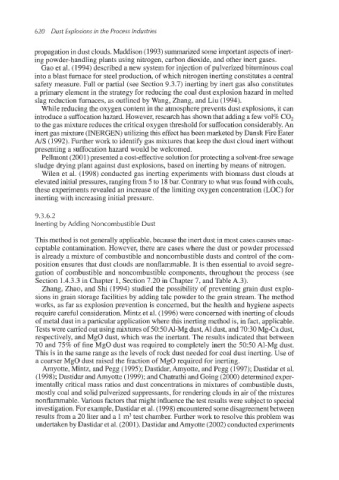Page 653 - Dust Explosions in the Process Industries
P. 653
620 Dust Explosions in the Process industries
propagationin dust clouds. Maddison (1993) summarized some importantaspects of inert-
ing powder-handling plants using nitrogen, carbon dioxide, and other inert gases.
Gao et al. (1994) described a new system for injection of pulverized bituminous coal
into a blast furnace for steel production, of which nitrogen inerting constitutes a central
safety measure. Full or partial (see Section 9.3.7) inerting by inert gas also constitutes
a primary element in the strategy for reducing the coal dust explosion hazard in melted
slag reduction furnaces, as outlined by Wang, Zhang, and Liu (1994).
While reducing the oxygen content in the atmosphereprevents dust explosions, it can
introduce a suffocationhazard. However,research has shown that adding a few vol% C02
to the gas mixture reduces the critical oxygen threshold for suffocationconsiderably.An
inert gas mixture (INERGEN)utilizing this effect has been marketed by Dansk Fire Eater
A/S (1992). Further work to identify gas mixtures that keep the dust cloud inert without
presenting a suffocation hazard would be welcomed.
Pellmont (2001)presented a cost-effectivesolutionfor protecting a solvent-freesewage
sludge drying plant against dust explosions, based on inerting by means of nitrogen.
Wilen et al. (1998) conducted gas inerting experiments with biomass dust clouds at
elevatedinitial pressures,ranging from 5 to 18bar. Contrary to what was found with coals,
these experiments revealed an increase of the limiting oxygen concentration (LOC) for
inerting with increasing initial pressure.
9.3.6.2
lnerting by Adding Noncombustible Dust
This method is not generally applicable, because the inert dust in most cases causes unac-
ceptable contamination. However, there are cases where the dust or powder processed
is already a mixture of combustible and noncombustible dusts and control of the com-
position ensures that dust clouds are nonflammable. It is then essential to avoid segre-
gation of combustible and noncombustible components, throughout the process (see
Section 1.4.3.3 in Chapter 1, Section 7.20 in Chapter 7, and Table A.3).
Zhang, Zhao, and Shi (1994) studied the possibility of preventing grain dust explo-
sions in grain storage facilities by adding talc powder to the grain stream. The method
works, as far as explosion prevention is concerned, but the health and hygiene aspects
require careful consideration.Mintz et al. (1996) were concerned with inerting of clouds
of metal dust in a particular application where this inerting method is, in fact, applicable.
Tests were carried out using mixtures of 50:50Al-Mgdust,A1 dust, and 70:30 Mg-Ca dust,
respectively, and MgO dust, which was the inertant. The results indicated that between
70 and 75% of fine MgO dust was required to completely inert the 50:50 A1-Mg dust.
This is in the same range as the levels of rock dust needed for coal dust inerting. Use of
a coarser MgO dust raised the fraction of MgO required for inerting.
Amyotte, Mintz, and Pegg (1995);Dastidar,Amyotte, and Pegg (1997); Dastidar et al.
(1998); Dastidar and Amyotte (1999);and Chatrathi and Going (2000) determinedexper-
imentally critical mass ratios and dust concentrations in mixtures of combustible dusts,
mostly coal and solid pulverized suppressants,for rendering clouds in air of the mixtures
nonflammable.Various factors that might influencethe test results were subject to special
investigation.For example,Dastidar et al. (1998) encountered some disagreementbetween
results from a 20 liter and a 1 m3test chamber. Further work to resolve this problem was
undertaken by Dastidar et al. (2001).Dastidar andAmyotte (2002) conductedexperiments

